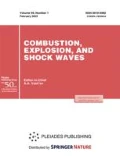Abstract
Many industrial combustion devices rely on jet flame combustion in the crossflow to achieve mixing and reaction. Previous research offers a limited predictive capability regarding the coupling effects of the crossflow and jet flow on the flame radiative fraction. In this work, a new theoretical equation is derived to relate the radiative fraction to the fuel flow rate and the crossflow velocity. The experimental results show that the flame length increases as the crossflow velocity increases for all considered flames. The results of this work suggest that the stretching factor is 0.08 s. The radiative fraction is almost independent of the nozzle diameter in the case of a low crossflow velocity. The crossflow has the strongest effect on the radiative fraction for a smaller nozzle diameter. This is because of the effect of the crossflow and jet flow velocities on the soot residence time, which is proportional to the radiative fraction.








Similar content being viewed by others
REFERENCES
A. R. Karagozian, “Transverse Jets and Their Control," Prog. Energy Combust. Sci. 36 (5), 531–553 (2010).
M. P. Escudier, “Aerodynamics of a Burning Turbulent Gas Jet in a Crossflow," Combust. Sci. Technol. 4 (1), 293–301 (1971).
T. A. Brzustowski, “The Hydrocarbon Turbulent Diffusion Flame in Subsonic Cross-Flow," in AIAA 15th Aerospace Science Meeting, 1977, pp. 24–26.
M. Fairweather, W. P. Jones, and R. P. Lindstedt, “Predictions of Radiative Transfer from a Turbulent Reacting Jet in a Cross-Wind," Combust. Flame 89 (1), 45–63 (1992).
M. S. Lawal, M. Fairweather, D. B. Ingham, et al., “Numerical Study of Emission Characteristics of a Jet Flame in Cross-Flow," Combust. Sci. Technol. 182 (10), 1491–1510 (2010).
O. A. Pipkin and C. M. Sliepcevich, “Effect of Wind on Buoyant Diffusion Flames. Initial Correlation," Ind. Eng. Chem. Fund.3 (2), 147–154 (1964).
L. W. Kostiuk, A. J. Majeski, P. Poudenx, et al., “Scaling of Wake-Stabilized Jet Diffusion Flames in a Transverse Air Stream," Proc. Combust. Inst. 28 (1), 553–559 (2000).
A. J. Majeski, D. J. Wilson, and L. W. Kostiuk, “Predicting the Length of Low-Momentum Jet Diffusion Flames in Crossflow," Combust. Sci. Technol. 176 (12), 2001–2025 (2004).
G. T. Kalghatgi, “The Visible Shape and Size of a Turbulent Hydrocarbon Jet Diffusion Flame in a Cross-Wind," Combust. Flame52, 91–106 (1983).
J. Wang, J. Fang, J. Guan, et al., “Effect of Crossflow on the Air Entrainment of Propane Jet Diffusion Flames and a Modified Froude Number," Fuel 233, 454–460 (2018).
J. Wang, J. Fang, L. Zhao, et al., “Sooting Tendencies of Propane Jet Diffusion Flame under Crossflow," Fuel 245, 247–252 (2019).
J. Wang, J. Fang, L. Zhao, et al., “Studies on the Radiation Fraction of Propane Jet Diffusion Flames under Crossflow," in Proc. of the 9th Int. Seminar on Fire and Explosion Hazards, April 21–26, 2019, St. Petersburg, Russia (Peter the Great St. Petersburg Polytech. Univ. Press, 2019), Vol. 1, pp. 116–124; http://doi.org/10.18720/SPBPU/2/k19-84.
J. Wang, J. Fang, S. Lin, et al., “Tilt Angle of Turbulent Jet Diffusion Flame in Crossflow and a Global Correlation with Momentum Flux Ratio," Proc. Combust. Inst. 36 (2), 2979–2986 (2017).
N. Peters, Turbulent Combustion (Cambridge Univ. Press, Cambridge, 2004).
L. Hu, Q. Wang, M. A. Delichatsios, et al., “Flame Radiation Fraction Behaviors of Sooty Buoyant Turbulent Jet Diffusion Flames in Reduced- and Normal Atmospheric Pressures and a Global Correlation with Reynolds Number," Fuel 116, 781–786 (2014).
J. Wang, J. Fang, J. Guan, et al., “Flame Volume and Radiant Fraction of Jet Diffusion Methane Flame at Sub-Atmospheric Pressures," Fuel 167, 82–88 (2016).
R. McMurray, “Flare Radiation Estimated," Hydrocarb. Process.61 (11), 175–181 (1982).
M. J. Hurley, D. T. Gottuk, J. R. Hall (Jr.), et al., SFPE Handbook of Fire Protection Engineering, (Springer, 2015).
Y. Oka, O. Sugawa, T. Imamura, and Y. Matsubara, “Effect of Cross-Winds to Apparent Flame Height and Tilt Angle from Several Kinds of Fire Source," Fire Saf. Sci. 7, 915–926 (2003).
M. A. Delichatsios and L. Orloff, “Effects of Turbulence on Flame Radiation from Diffusion Flames," Proc. Combust. Inst.22 (1), 1271–1279 (1989).
T. A. Brzustowski, S. Gollahalli, M. Gupta, et al., “Radiant Heating from Flares," ASME Paper No. 75-HT (1975), p. 4.
Author information
Authors and Affiliations
Corresponding author
Rights and permissions
About this article
Cite this article
Wang, JW., Fang, J., Guan, JF. et al. Radiative Fraction and Flame Length of Propane Jet Diffusion Flames in a Crossflow. Combust Explos Shock Waves 56, 375–382 (2020). https://doi.org/10.1134/S0010508220040012
Received:
Published:
Issue Date:
DOI: https://doi.org/10.1134/S0010508220040012


